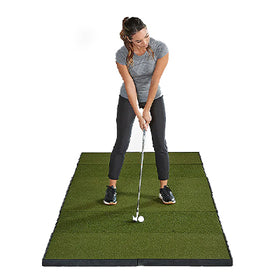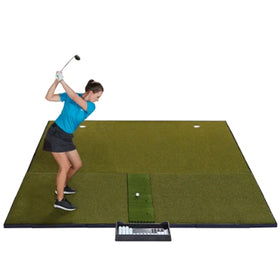Installation Recommendations
Outdoors
It is best to install Fiberbuilt golf mats and putting greens on a firm, flat surface. Suitable locations include concrete pads, asphalt pads, wood decks or patio stones, or firm, packed crushed stone. It is best not to install on grass as the mat will kill your grass and the surface under the mat will be unstable. If you are installing on concrete it is best to ensure that there is a 2% slope to allow for adequate drainage under the mat.
Indoors
Fiberbuilt golf mats and putting greens can be installed on indoor surfaces including concrete or carpeted floors. If installing on carpet you may notice that your mat will move slightly with the grain of the carpet while you are hitting. If this is the case, you will need to install some light duty two-way carpet tape underneath the frame of your mat to anchor it down.
Product Maintenance
Regular maintenance of your Fiberbuilt® Golf Mat System will ensure maximum life for the components.
Fiberbuilt® Grass Surface
Maintenance: The Fiberbuilt® Grass surface consists of 4 individual panels that can be rotated for maximum life. Below is a photo of the rotation pattern options.
The middle panel(s) will eventually show wear, the entire hitting surface can be rotated 180o for continued use. When the middle panel(s) need replacing, remove them from the hitting surface, bring the outside panels to the centre and replace the outside panels with 2 new ones OR as shown below, when you have two hitting surfaces take the 2 end panels from the panel ‘B’ 4-pack and use them to replace the worn inner panels just removed from panel ‘A’.

To rotate the panels, remove the L-channel brackets and separate the four panels that make up the driving surface. Rotate the panels so that you have a ‘new’ panel in place of where the rubber tees would be placed. Once the panels have been rotated, to re-assemble the panel components evenly and securely us a rubber hammer and “jig” to fasten the components back in place. It is important that all four components are level to recreate the smooth hitting surface.
Once the four panels have been re-assembled you can attach the “L channel”. You will need to shift the ‘L channel” slightly, drill the self-taping Robertson #2 screws into the bottom of the panel. Do not reuse the same holes.
Cleaning: The grass hitting surface should be pressure washed once per year to remove any sand or dirt that has accumulated in the nylon fibers.
Stance Mat
Cleaning: The turf stance mats should be removed from the rubber foundation to be pressure washed every few months. Sand and dirt collects in the nylon fibers of the turf stance mat and will deteriorate and damage the nylon if it is not washed regularly.
Maintenance: The stance mat is square to enable you to rotate the mat to balance wear. If you have rubber stance mats, sweeping and pressure washing with water will keep them clean. Never apply any cleaning or shining agents to the stance mat.
Rubber Foundation
Maintenance: The rubber foundation should be swept out occasionally. The frame may also be pressure washed. You will need to ensure that the drainage holes do not plug up with sand and dirt. You may also consider drilling additional holes into the rubber foundation to accelerate the water drainage.To keep your rubber foundation looking clean and new, you can apply tire cleaner (like Armor All) to the outside edges only.
Ball Trays
Maintenance: Ball Trays should be swept and cleaned occasionally and may also be pressure washed. To keep ball trays looking new, apply a tire cleaner (like Armor All) to the ball trays.
Off-Season Storage
Stack the hitting surface vertically against a wall and stack only 5-8 deep. Do NOT stack the hitting surface horizontally on top of each other; this will flatten the nylon fibers. The turf stance mats and the rubber foundations can be stacked on each other horizontally. Do not mix the stack.




